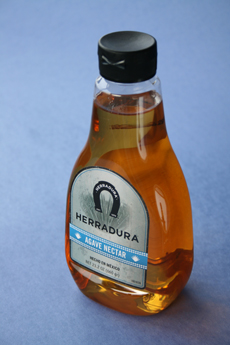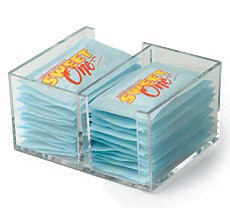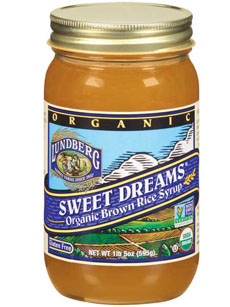Glossary Of Natural & Artificial Non-Caloric SweetenersPage 7: Glossary Of Artificial Sweeteners A & B This is Page 7 of an 11-page article. Click on the red links below to visit other pages. This glossary is protected by copyright and cannot be reproduced in whole or part. You are welcome to link to it.
|
 Agave nectar is a boon to people who want natural sweetness with a very low glycemic index. Photo by Hannah Kaminsky | THE NIBBLE. |
|
|
Glossary Of Natural & Artificial Non-Caloric Sweeteners
A non-caloric sweetener has no calories. It can be a natural product, like stevia, which is derived from a plant leaf; or a chemically-derived product, which comprises the majority of non-caloric sweeteners. An asterisk (*) in this glossary indicates a natural product, i.e., one derived principally from a plant or other natural product.
|
||
|
ACESULFAME-K or ACE-K (Sunett, Sweet One)
Acesulfame-K, measure for measure 200 times sweeter than table sugar, is, along with sucralose, one of the more recently approved sugar substitutes. Ace-K was approved for use in soft drinks in 1998, and as a flavor enhancer in 2003. It contains no calories. It is often combined with other sweeteners to intensify the sweet taste and reduce any bitterness. The sucralose (Splenda)/Ace-K blend has become a popular ingredient in baked goods because of the natural taste and its ability to retain sweetness when heated to high temperatures. Humans cannot digest acesulfame-K so no calories are absorbed. It can withstand high temperatures and thus can be used in cooking and baking. It has been tested less thoroughly than aspartame, so researchers tend to know less about it. It is O.K. for cooking. The FDA Acceptable Daily Intake is 15 mg per kg, or 25 cans of diet soda.† Critics claim that approval of Ace-K was based on poorly designed studies, flawed data and questionable interpretation of statistics. the FDA has turned down proposals to further test Ace-K, as well as aspartame, and other sweeteners. __________ |
 Ace-K is typically used industrially, in a blend with aspartame or other sweetener. However, it can also be purchased in packets by consumers. |
|
|
AGAVE NECTAR or AGAVE SYRUP
Agave (pronounced uh-GAH-vay) is a botanical family of succulent plants, Agavaceae, with more than 400 species, that grow chiefly in Mexico and the southwestern U.S. The sap of one species, Agave tequilana Weber, known as the blue agave or tequila agave, is used to make tequila. fermented and distilled into mezcal and tequila. Agave is produced commercially in Mexico from several species of agave, including blue agave, green agave, grey agave, rainbow agave, salmiana agave and thorny agave. The sap from the leaves, called agave syrup or agave nectar, is a very pleasant sweetener which tastes a bit like light honey; a darker version of the nectar has a deeper flavor, more like brown sugar or maple syrup. Agave nectar is the lowest qualified sweetener on the glycemic index.* Agave nectar has a glycemic index (GI) of 32, half that of sugar. Honey has a GI of 58, due to its higher ratio of glucose to fructose (agave is about 90% fructose; note that some honeys are lower glycemic than others). Table sugar has a GI value of 60-65. Pure maple syrup maple syrup has a GI of 54. A teaspoon of agave is 20 calories, and table sugar is 16 calories (honey has 22 calories). But since agave is 1.4 to 1.5 times sweeter than sugar, you don’t need as much. See also fructose __________ |
 The blue agave plant, from which both tequila and agave nectar are made (photo courtesy Nectar.com).  A field of agave plants (photo courtesy Tequila Herradura). |
|
|
ASPARTAME (Equal)
Approved in 1981 by the FDA, aspartame is measure for measure 160 to 200 times sweeter than sugar. It contains the two amino acids, phenylalanine and aspartic acid, and is an excellent sweetener with no aftertaste. It has about 4 calories per gram, but because of its intense sweetness, very little is used so the amount of calories it provides is negligible. Aspartame is heat-stable and suitable for cooking and baking. While the product claims to have a shelf life of three years or longer, our anecdotal experience is that its sweetness will denature (break down), which is why a can of diet soda that’s a year old can taste undrinkable while its high fructose corn syrup counterpart is fine. Aspartame contains phenylalanine, an amino acid, which some people with a very rare condition called phenylketonuria (PKU) are unable to metabolize; so all food products containing aspartame carry a warning about its phenylalanine content. Aspartame breaks down under heat so cannot be used in cooking. The FDA Acceptable Daily Intake is 50 mg per kg of body weight, or 15-20 cans of diet soda, or 97 packets of Equal, for a 150-pound person.†† It is deemed safe by the World Health Organization and the Centers for Disease Control and Prevention.
|
 Aspartame is sold as a generic for industrial use. The most popular consumer brand is Equal. |
|
|
BROWN RICE SYRUP or BRAN SYRUP or RICE MALT
Brown rice syrup is a low-glycemic sweetener, with a GI of 20. This means that its complex sugars are absorbed more slowly into the bloodstream—usually a boon for people with diabetes. However, it is not recommended for diabetics. That’s because its sweetness comes from maltose, which causes spikes in blood sugar. But, as with everything related to your health, check with your healthcare provider. Brown rice syrup is about half as sweet as table sugar (GI value of 60-65) and one-third as sweet as agave syrup/nectar (GI value of 22).
Continue To Page 8: Glossary Of Terms Beginning With C To K |
 Brown rice syrup has a lower GI than agave, but is not recommended for diabetics. Photo courtesy Lundberg. |
|
Last Updated Jun 2018
© Copyright 2005-2025 Lifestyle Direct, Inc. All rights reserved. All images are copyrighted to their respective owners.